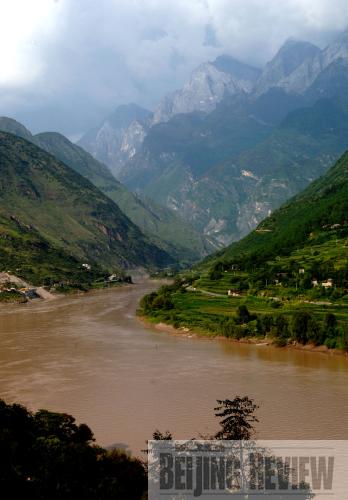|
 |
|
VULNERABLE VALLEYS: The photo shows the stretch of Jinshajiang River where it runs parallel to Lancangjiang and Nujiang rivers. The construction of hydropower plants around this area has stirred controversy due to the potential damage to the local environment (JIANG ENYU) |
While hydropower is usually regarded as a safe and clean alternative energy source, China's top environmental regulator temporarily reined in two such projects that it said were set to cause part of the Yangtze River in Yunnan Province undue harm.
On June 11, the Ministry of Environmental Protection (MEP) announced it was suspending its approval of construction applications for China Huaneng Group and China Huadian Corp. as punishment for the two power giants' illegal construction in January of two cofferdams on the Jinshajiang River, around the upper reaches of the Yangtze. The cofferdams, large watertight structures used for underwater construction, were put in place for the initial building phase of the hydropower facilities. However, neither cofferdam had received prior approval through the environmental impact assessment (EIA) process, as regulated by the Law on Environmental Impact Assessment. The two projects were expected to cost almost 30 billion yuan ($4.4 billion).
MEP spokesman Tao Detian said on June 11 that the punishment meted out to the companies should also serve as a warning to all others invested in high-pollution, energy-intensive or resource-mining projects, that they should take responsibility to protect the environment and fulfill their corporate social responsibility.
The Law on Environmental Impact Assessment, which came into effect in 2003, requires every new construction project to submit an EIA report that must be approved by environmental authorities before construction starts. It is considered groundbreaking for granting environmental protection authorities the power to halt construction projects that have the potential to damage ecology.
Though the Central Government encourages the development of renewable energy projects, including hydropower, plans should not overwhelm local ecosystems or allow rivers to grow overcrowded with hydropower dams, said a representative from MEP's EIA department. The department reported that over 75 percent of China's hydropower is in the southwest, an area that holds the country's richest biodiversity and most vulnerable ecosystems. It is also the most prone to geological disasters. The representative said projects undertaken without EIA approval tend to inflict irreversible damage on the local environment.
| 